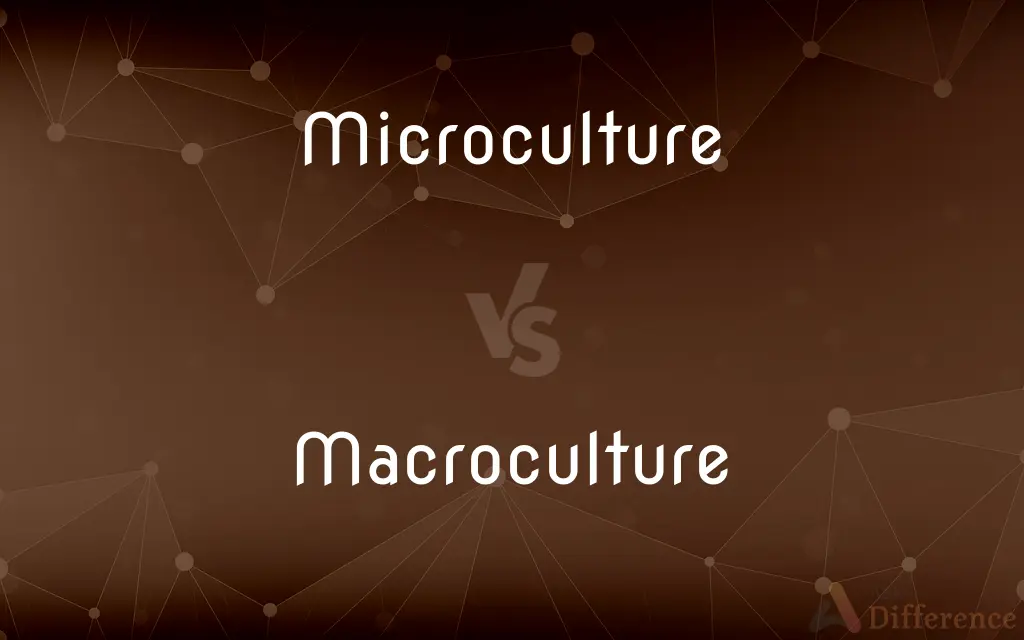Microculture vs. Macroculture — What's the Difference?
By Urooj Arif & Fiza Rafique — Updated on April 1, 2024
Microculture refers to the specific cultural practices of a small group, while macroculture encompasses the dominant cultural norms of a larger society.

Difference Between Microculture and Macroculture
Table of Contents
ADVERTISEMENT
Key Differences
Microcultures represent the unique traditions, behaviors, and values of smaller groups within a broader society, highlighting the diversity and specificity of human social arrangements. These groups can be based on hobbies, professions, or social interests, providing a sense of identity and belonging to their members. In contrast, macroculture refers to the overarching cultural framework that defines a larger society or nation, setting the standard norms, values, and practices that are widely recognized and practiced by the majority of the population.
While microcultures focus on the specific and sometimes niche aspects of human life, offering richness and diversity within a larger societal context, macrocultures establish a common ground that unites various groups within a society, promoting social cohesion and national identity. Microcultures thrive on differentiation and the celebration of unique identities, whereas macrocultures tend to emphasize similarities and shared values among its constituents, sometimes at the expense of marginalizing smaller, less conforming groups.
The interaction between microculture and macroculture is dynamic and constantly evolving. Microcultures can influence the macroculture by introducing new ideas, practices, and innovations that may be adopted into the mainstream. Conversely, macroculture sets the overall context within which microcultures operate, often determining the broader societal acceptance or marginalization of these smaller groups. This relationship is a testament to the fluid nature of culture and its ability to adapt and evolve over time.
In terms of social influence, microcultures offer individuals the opportunity to express themselves within a supportive community that shares specific interests or values, providing a space for personal growth and development. Macroculture, however, wields a significant influence over public discourse, norms, and the legal framework within which societies operate, affecting the lives of individuals on a more general level. The balance between these cultural levels is essential for fostering a society that values diversity while maintaining a cohesive and functional social order.
Public policies and social movements often arise from the tension between microcultures and macrocultures, with efforts to address issues of representation, equity, and inclusion highlighting the need for a harmonious coexistence of diverse cultural expressions within a unified societal framework. This dynamic interplay between the specific and the general, the small-scale and the large-scale, characterizes the complexity of human societies and the ongoing negotiation of cultural identity and belonging.
ADVERTISEMENT
Comparison Chart
Definition
Specific cultural practices of a small group.
Dominant cultural norms of a larger society.
Scope
Small, often niche groups.
Broad, encompassing entire societies.
Influence
Provides identity and belonging on a personal level.
Shapes public discourse, norms, and laws.
Interaction
Can influence macroculture with new ideas.
Sets the context for microcultures.
Social Role
Celebrates uniqueness and diversity.
Promotes social cohesion and national identity.
Compare with Definitions
Microculture
A culture that exists within a specific organization, group, or interest area.
Skateboarders have their own microculture with unique slang, fashion, and values.
Macroculture
Influences the overarching identity of a country or society.
The principle of liberty, equality, fraternity in French macroculture.
Microculture
Influences the behaviors and practices of its members.
The microculture of a tech startup might encourage innovation and risk-taking.
Macroculture
Represents the dominant cultural norms and values of a society.
The American Dream reflects an aspect of the United States' macroculture.
Microculture
Is dynamic and evolves with its members.
The microculture of online gaming communities adapts quickly to new technologies and games.
Macroculture
Shapes the legal and social framework within which people operate.
The emphasis on democracy and individual rights in Western macrocultures.
Microculture
Provides a sense of identity and community.
Cosplayers form a microculture that celebrates creativity and fandom.
Macroculture
Promotes national unity and identity.
National holidays and symbols like the flag are expressions of a country's macroculture.
Microculture
Can be based on ethnicity, religion, hobbies, or professions.
The Amish community represents a microculture within the United States.
Macroculture
Is affected by the integration and assimilation of various microcultures.
The influence of immigrant cultures on American food, language, and holidays.
Microculture
Microculture refers to the specialised subgroups, marked with their own languages, ethos and rule expectations, that permeate differentiated industrial societies.A microculture depends on the smallest units of organization – dyads, groups, or local communities – as opposed to the broader subcultures of race or class, and the wider national/global culture, compared to which they tend also to be more short-lived, as well as voluntarily chosen. The study of kinesics – the nonverbal behavior of the small gathering – can be used to illuminate the dynamics of a given microculture.
Macroculture
The dominant culture in a society, its overculture; a collection of related microcultures
Microculture
(Biology) A small-scale culture of microorganisms, cells, or tissues.
Microculture
(Sociology) The distinctive culture of a small group of people within a limited geographical area or within an organization such as a school or business.
Microculture
A very small (niche) culture.
Common Curiosities
How do microcultures affect macroculture?
Microcultures can introduce new ideas, practices, and innovations that may be adopted by the broader society, influencing the macroculture.
Can an individual belong to multiple microcultures?
Yes, individuals often participate in multiple microcultures based on their interests, professions, and social groups.
Why is macroculture important?
Macroculture is important because it establishes a common set of norms and values that guide public discourse, laws, and societal cohesion.
How does macroculture differ from microculture?
Macroculture refers to the dominant cultural norms and values that define the larger society or nation, in contrast to the specific practices of microcultures.
Can macroculture change over time?
Yes, macroculture can evolve as it integrates elements from various microcultures and adapts to changes in societal values and global influences.
How do social movements interact with microcultures and macrocultures?
Social movements often emerge from microcultures challenging aspects of the dominant macroculture, seeking to shift societal norms and values.
What is a microculture?
A microculture refers to the cultural patterns and practices of a specific, often smaller, group within a broader society.
What role do governments play in shaping macroculture?
Governments can influence macroculture through policies, education, and public messaging that promote certain values and norms.
How does globalization affect microcultures and macrocultures?
Globalization can lead to the spread of macrocultural values across the world while also providing a platform for microcultures to share their practices and perspectives internationally.
What is the significance of understanding microcultures in a multicultural society?
Understanding microcultures is crucial for fostering inclusion, respecting diversity, and promoting a harmonious coexistence within a multicultural society.
Share Your Discovery

Previous Comparison
Splatter vs. Spit
Next Comparison
Wrap vs. ParcelAuthor Spotlight
Written by
Urooj ArifUrooj is a skilled content writer at Ask Difference, known for her exceptional ability to simplify complex topics into engaging and informative content. With a passion for research and a flair for clear, concise writing, she consistently delivers articles that resonate with our diverse audience.
Co-written by
Fiza RafiqueFiza Rafique is a skilled content writer at AskDifference.com, where she meticulously refines and enhances written pieces. Drawing from her vast editorial expertise, Fiza ensures clarity, accuracy, and precision in every article. Passionate about language, she continually seeks to elevate the quality of content for readers worldwide.
















































